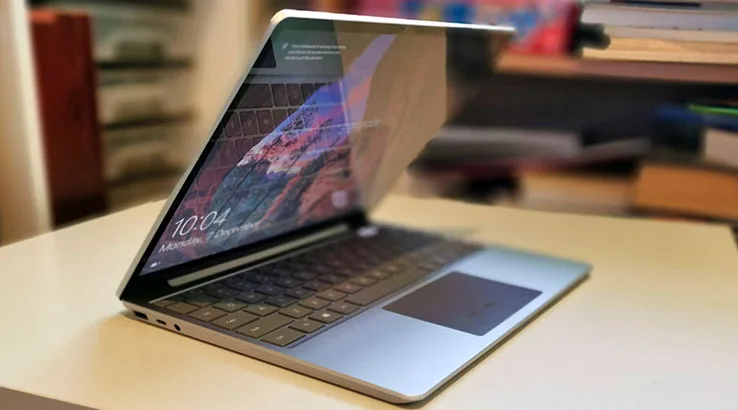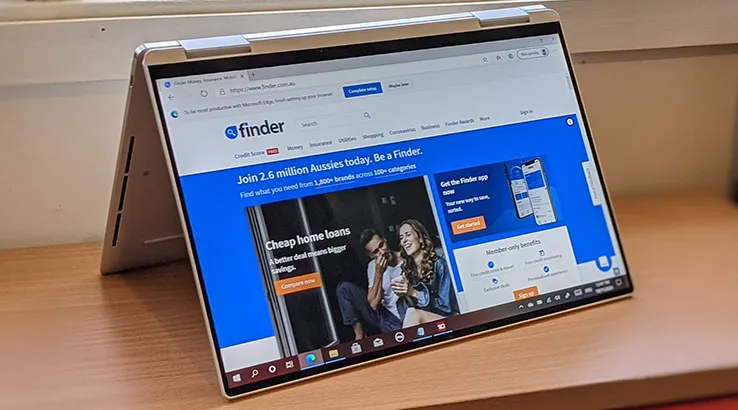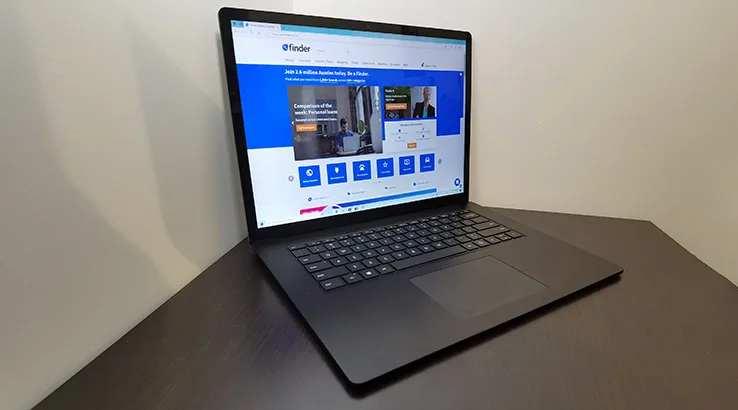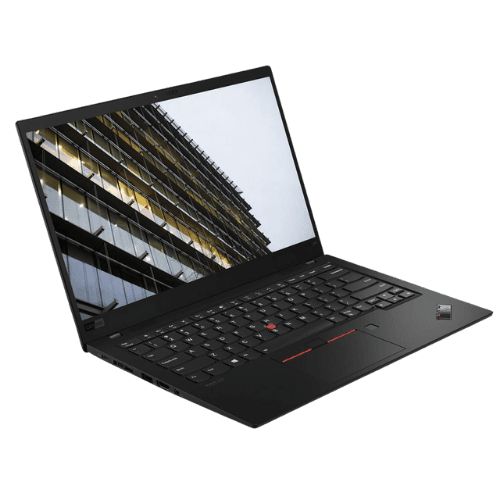Top Pick for
Windows ultrabook

Top Pick for
Windows ultrabook

Top Pick for
Gaming ultrabook

Top Pick for
Big-screen ultrabook

Top Pick for
Ultrabook for students

Finder's team thoroughly examined more than 60 ultrabooks, selecting these top picks based on customer and professional reviews. We looked into the features and performance of those devices to determine which were the best fit for each use case.

Apple's sleek MacBooks have always been the pinnacle of the thin and light laptop space. These ultrabooks have always sported unmatched quality, formidable battery life and speedy performance. Apple has taken all of that to the next level with its new MacBook Pro 13 inch, making it the best overall ultrabook that money can buy.
The latest 13-inch MacBook Pro keeps the same sleek design that the line has had for the last few years, with a solid all-metal construction, stunning Retina display and, love it or hate it, the Touch Bar. Unfortunately, that means you're still stuck with very few ports: just two USB-C ports and a headphone jack. There isn't anything that visually sets this apart from any other recent MacBook Pro models. Instead, all of the latest improvements are under the hood.
Rather than using Intel processors like previous models, the new MacBook Pro bears Apple's M1 chip. Since it's designed in-house, Apple can crank an insane amount of performance out of the little processor. While it's super energy-efficient, its eight cores make for the speediest macOS experience seen to date. That energy efficiency also means it's the longest-lasting Mac ever, capable of up to 20 hours of battery life per Apple. This new chip isn't perfect, though. Apps that aren't built for the M1 chip won't run as smoothly, though the Rosetta 2 interface means they should still run fine.
Like other MacBooks, the 13-inch Pro has seamless integration with the Apple ecosystem. It's the perfect companion for any iPhone user, with FaceTime, iMessage and more baked right into macOS. A built-in fingerprint reader means you can unlock the MacBook Pro with Touch ID like you would an older iPhone, and there's Apple Pay for simple and secure online payments.
The MacBook Pro 13 inch with Apple's M1 chip is one of the highest-rated devices we've ever seen on Google, with a rating of 4.8 out of 5 from more than 3,000 reviews. Customers were super impressed with the ultrabook's battery life, the Retina display and the refined Magic Keyboard. Some weren't so pleased that Apple still wasn't offering a touch-enabled screen on the MacBook Pro, though.

Long considered one of the best high-end Windows laptops, Dell's XPS 13 is a fantastic performer in a premium, thin and light body. Its spectacular screen and speedy 11th generation Intel processors put it above the rest, making it overall the best Windows-based ultrabook you can buy.
Performance on the XPS 13 is about what you'd expect from a pricey ultra-portable laptop. You'll find the 11th generation of Intel Core i5 and i7 processors on-board the XPS 13, which have Intel's Xe graphics baked in. It'll work like a champ for day-to-day tasks like word processing, web browsing and will even do just fine with lighter professional workloads like photo editing. And while that graphics chip is better than last-generation integrated graphics, you still won't be able to squeeze super high frame rates out of it in the latest games.
Dell isn't messing around when it comes to screen quality. Not only is the UHD+ model of the 13.4-inch display bright and touch-enabled, it's also loaded with Dolby Vision support for vibrant, industry-leading HDR video and has fantastic colour accuracy. All of that is packed into a tiny package, with the InfinityEdge display sporting a whopping 91.5% screen to body ratio.
Like older models, the latest XPS 13 sports a clean aluminium shell, and either a carbon fibre or glass fibre palm rest. These premium materials not only make the XPS one of the most visually appealing devices on the market, but it also ensures its durability for the long term.
Customers awarded the latest model of the XPS 13 a 3.8 out of 5 rating on Dell's website, with users praising its sharp display and fantastic performance. However, some were unhappy with the quality of the webcam.

Microsoft knows a thing or two about making fantastic yet pricey laptops. Targeting those on a tighter budget, the company took its Surface Laptop and crammed it into a more affordable, miniature package. With models starting at just $999, the Surface Laptop Go is the best ultrabook under $1,000 currently on the market.
Microsoft used its familiar and sleek design language on the Surface Laptop Go, keeping that same slim and rounded aesthetic found on the Surface Laptop 3. Thankfully, the laptop also keeps the aluminium lid from its bigger sibling. Though, something had to give to keep the price below that $1,000 sweet spot somehow. The base of the ultrabook isn't a premium metal. Instead, it's a polycarbonate made up of glass fibre and recycled materials.
You won't have to worry about being able to fit the Surface Laptop Go in a bag. Weighing in at merely 1.11kg, it's one of the lightest ultrabooks you can buy without sacrificing on quality. Even with a 12.4-inch PixelSense display, LPDDR4x RAM and a 10th generation Intel Core i5 processor, the device is just 15.69mm thick. That's even more impressive when you consider Microsoft says the battery can keep the laptop running for 13 hours. Unfortunately, you don't have many options on the storage front. The Surface Laptop Go only has 64GB of eMMC storage on the base model, and the top-of-the-line device has just 256GB. The PixelSense display is a little underwhelming, too, with a resolution (1536x1024) below that of full HD.
The Surface Laptop Go commands an impressive 4.5 out of 5 rating from almost 900 reviews on Google, and received a Finder score of 3.5 in our full review. Many customers were pleased with the device's solid-feeling build quality, but some suggested going with a higher-spec model with more memory rather than settling for the base model.

When you think of a computer with great gaming performance, you usually wouldn't think of a thin and light ultrabook. Asus wants to change that mindset, with its AMD graphics-equipped Zephyrus G14 fitting into a compact and premium ultrabook form-factor while still cranking out impressive frame rates in games. All of that and more makes the G14 the best gaming ultrabook you can buy.
Asus managed to pack up an AMD Ryzen 9 4900HS processor and RTX 2060 graphics card into the less-than-2cm-thick body of the gaming ultrabook, giving it killer performance in even the latest games. What's more impressive is that the company squeezed all of those frames into a chassis that weighs in at just 1.6kg (or 1.7kg with the AniMe Matrix display).
Featuring a full HD 14-inch IPS anti-glare display, the Zephyrus G14 is suitable for a range of applications from casual browsing to watching videos, and of course, playing the latest games. The lower-end models have a refresh rate of 60Hz, while higher-end ones go up to 120Hz for a more responsive gaming experience. There are also QHD panels available, and while they have a better resolution, they're locked to 60Hz too.
While the G14 might seem like a laptop that can do it all, it has one notable omission: there's no webcam. In an era where video conferencing via Zoom or Microsoft Teams is becoming commonplace, it's not something that you can ignore.
One of the most unique selling points of the Zephyrus G14 is its AniMe Matrix display on the lid, which allows users to show off their creative side by customising those 1,125 mini-LEDs. Unfortunately, the feature is only available on some of the G14 models. Even with all of those perforations on the lid, the G14 looks stylish and modern. It doesn't look like your typical high-performance gaming laptop.
The Zephyrus G14 is an incredibly well-liked gaming ultrabook, with a 4.5 out of 5 rating from more than 2,000 reviews on Google. Users praised its build quality, materials and components across the board, even on the lower-spec models. Some complained of poor cooling performance, and keyboard backlight issues seem to be widespread.

By taking one of the most popular premium Windows devices on the market and scaling it up to sport a whopping 17-inch display, Dell has created the best big-screen ultrabook that money can buy.
The XPS 17 is built like a laptop for creatives, with the mouthwateringly-pretty InfinityEdge display sporting fantastic colour accuracy. With 100% coverage of the Adobe RGB colour space and 94% of the DCI-P3 gamut, the ultrabook is a more than capable device for all sorts of colour-sensitive work. If that wasn't enough, there's also industry-leading HDR support with Dolby Vision.
The XPS 17 has four USB-C ports with Thunderbolt 3, which also act as charging ports and display outputs. There's also a full-sized SD card reader for seamless footage and photo transfers on the go, a headphone jack and a Kensington lock. Unfortunately, there are no USB-A ports so you'll need to lug around adapters for older devices.
The XPS 17 can be kitted out with some seriously high-end performance gear, though you'll need to take out a second mortgage. If you've got cash burning a hole in your wallet, the model with an 8-core Intel Core i9 processor and an Nvidia RTX 2060 Max-Q graphics card will conquer pretty much anything you put in its path, from gaming to video editing to web browsing.
Unless you're happy to settle for lesser performance and desperately need an ultrabook with a gigantic screen, please don't buy the base model of the XPS 17. You'll be let down by the device's relatively little RAM, average screen resolution and middling processor. To fully appreciate the magnificence of the XPS 17, you'll want a model that at least has an Nvidia GeForce GTX 1650 Ti graphics card and the UHD+ display.
More than 1,800 customers on Dell's site gave the laptop an average rating of 4.1 out of 5 stars, with many professional reviewers giving the ultrabook similar scores, ranging from 4 to 4.5 out of 5. Broadly, customers praised the XPS 17's giant display as beautiful and clear. Some were unhappy with the amount of pre-installed software that came on such a premium device.

A compelling on-the-go mix between a thin and light laptop and a tablet, the XPS 13 2-in-1 features all of the great things you've come to expect from the XPS line-up such as fantastic build quality and a clear display. While the pricey device has a few shortcomings, it's the best 2-in-1 ultrabook money can buy. The ultrabook also scored the number 1 spot in our best 2-in-1 laptops roundup.
Like other XPS models, the 2-in-1 ultrabook is built incredibly well. Dell continues to use premium materials such as aluminium and carbon fibre across the entire XPS product line, allowing them to stand the test of time. Complementing the laptop's build quality is its internals, headlined by the latest 11th generation Intel Core i5 and i7 processors. Sporting Intel's new Evo certification, the XPS 2-in-1 is a speedy, responsive and efficient laptop. The Evo sticker also means the ultrabook has instant wake, making the device ready in an instant. Unfortunately, you're stuck using the integrated Intel Iris Xe graphics. It's better than Intel's previous-generation graphics tech, but it won't make for a pleasant gaming experience.
The XPS 13 2-in-1 has an unimpressive port selection, with just two USB-C ports. Thankfully, those ports have Thunderbolt 4, letting you plug in resource-hungry external devices like graphics enclosures and lightning-fast SSDs. There's also a micro SD card slot and a 3.5mm headphone jack.
The XPS 13 2-in-1 received a Finder score of 4 in our full review, where it received praise for its power but lost points for its limited port selection. Many customers were happy with the ultrabook's keyboard, although others found it loud. Some customers weren't as impressed with the laptop's convertible hinge.

Microsoft's third iteration of its Surface Laptop is a portable, superbly built device that's easy to carry around campus and is perfect for taking notes in classes or lectures. With almost everything a student could need in an ultrabook, Surface Laptop 3 is the best choice for those getting an education.
Microsoft has excelled at building a sturdy and premium laptop, with the Surface Laptop 3 sporting an entirely aluminium casing. Not only does the aluminium make the ultrabook look stunning, but it'll age much better than a laptop made from plastics. Some models have metal palm rests, while others use Alcantara material. Both materials feel premium, though the Alcantara may get dirty over time.
The Surface Laptop 3 has a 13.5-inch PixelSense display with a 2256x1504 resolution, making it crisper than full HD but less sharp than QHD. If the 13.5-inch screen isn't enough for you, you can grab the 15-inch model. Design-wise, the 13.5- and 15-inch models are identical, and even have the same typical battery life of 11.5 hours. On the inside, the 15-inch model has AMD Ryzen processors and Radeon Graphics, as opposed to the Intel Core i5 and i7 processors found on the 13.5-inch model.
Both models of the Surface Laptop 3 only have 1 USB-C port and 1 USB-A port. Microsoft has never offered a laptop with a heap of ports, but having just one of each is super disappointing. At least that USB-C port isn't reserved for charging, which happens via the Surface Connect port as usual.
The Surface Laptop 3 has an impressive 4.6 out of 5 rating from more than 2,800 reviews on Google, with customers labelling it as a fantastic Mac alternative and one of the best ultrabooks in its class. Many loved the laptop's design and its fantastic keyboard, but some took issue with the lack of ports.

Lenovo's new 8th generation X1 Carbon ultrabook takes business seriously, with enhanced privacy features, fantastic portability and plenty of power under the hood. There's no doubt that this built-for-work laptop is the best ultrabook for business on the market today.
Running on Intel's 10th generation Core i5 and Core i7 processors, the X1 Carbon has plenty of performance to get you through the workday. You can choose between either 8GB or 16GB of memory, depending on how resource-hungry your workloads are. If you're mainly just using the laptop for word processing, emails and some Excel, 8GB will do you just fine. What might not do you just fine is the low-resolution 720p webcam. While it's the industry standard, you might expect a higher-quality camera on a laptop built for work, especially in an era where more and more people are working from home.
Lenovo baked security and privacy into the X1 Carbon's DNA. The business-ready ultrabook comes equipped with ThinkShutter, a physical webcam shutter. While it's just a bit of plastic, it gives you peace of mind that you're not being watched. The X1 also sports Lenovo's PrivacyGuard technology, which reduces the screen's viewing angles so others can't snoop on your work. There's even a model with an optional infrared camera, which notifies you when someone's got their prying eyes on your work.
While the X1 Carbon is the best ultrabook for business users, it's not really suitable for anything else. The device lacks the horsepower to do anything more hardware intensive, like gaming or video editing. You're limited with display options, too, with none of them sporting the resolution or colour accuracy to make the ultrabook a viable pick for creative work.
The latest edition of the X1 Carbon saw an Amazon rating of 4.7 out of 5, with more than two dozen customers giving their thoughts on the business-centric device. Some customers were satisfied by the ultrabook's lightweight feel, though the placement of the laptop's power button on the right-hand side of the device was a pain point for some.

For many, being able to do even the most demanding work on the go is crucial. Apple's MacBook Pro 16 inch, with its high-performance components and big, sharp screen, is the perfect fit for those who need some serious performance and colour accuracy no matter where they are. Combine that with the laptop's great build quality and Apple ecosystem integration and the MacBook Pro is the best ultrabook for professionals that you can get your hands on today.
Apple's Retina displays are always some of the best you can find on any laptop, and the 16-inch IPS panel on the MacBook Pro is no different. With 226 pixels per inch, 500 nits of brightness and great colour accuracy, the screen produces crisp visuals and is suitable for most creative and professional work. The ultrabook has a bizarre resolution of 3072x1920, which is more than QHD but less than 4K.
When it comes to performance, the MacBook Pro is no slouch. With either an Intel Core i7 or Core i9 processor and a dedicated AMD Radeon Pro graphics card, the big-screen ultrabook works a treat for almost any on-the-go workload. You'll be able to crank out some light gaming on the laptop, too, but don't expect super impressive frame rates. Apple is yet to refresh the 16-inch MacBook Pro with its impressive new M1 chips, so some may want to hold out for the rumoured release coming later in 2021.
Given the powerful components and super-bright screen, the 16-inch MacBook Pro needed a sizable battery. Naturally, Apple paired those power-sucking parts with the maximum-sized battery allowed on commercial aircraft in the United States: 100-watt hours.
The big and powerful 16-inch MacBook Pro has earned itself a 4.8 out of 5 rating from more than 6,000 user reviews on Google, making it one of the most highly regarded devices on the market. Customers were pleased with the massive Retina display, which is suitable for almost any workload. Many liked the somewhat controversial Touch Bar, too. Some mentioned that creatives doing heaps of editing might want to go for a higher-spec model with more RAM, and others were upset at the inclusion of just four USB-C ports, with no conventional USB-A ports.
We compared a gamut of ultrabooks from the brands mentioned below, eliminating any and all options that aren't easy for Australians to pick up either in-store or online:
We evaluated the core parts that can make or break an ultrabook, such as battery life, build quality, port selection, portability, screen size and display quality, performance and value for money. The devices selected had to excel in these areas when compared to the competition.
After reading hundreds of reviews left by customers (as of January 2021) and extensively assessing each device ourselves, we picked out the 9 best ultrabooks on the market today to help anyone looking to make their decision.
If you're in need of a new laptop, don't miss out on the exceptional savings these deals have to offer.
Work, learn and play with one of the best Chromebooks you can get your hands on in Australia right now.
From the best option for gaming to the top model for battery life, these are the 9 best student laptops online.
These are the 9 best cheap laptops you can get right now in Australia.
Our expert team spent hundreds of hours testing laptops to find the six best 2-in-1 laptops you can buy.
Shop across a great range of laptop models at these trusted online stores.